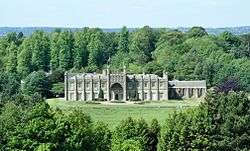Donington Hall

Donington Hall is a house and residential 1,100-acre (4.5 km2) estate in Castle Donington, North West Leicestershire, located close to the city of Derby. The hall served as the headquarters for the airline British Midland International until it was merged into British Airways on 28 October 2012. It is now the headquarters of the Norton Motorcycle Company.
History
The house was built from c 1790[1] for Francis Rawdon-Hastings, 2nd Earl of Moira, (created Marquess of Hastings in 1816) in a fanciful Gothic manner by the plasterer and draughtsman William Wilkins the Elder.[2]
It passed in 1826 to the young George, a foxhunting addict who kept his own pack of hounds at the hall in purpose-built kennels. George died an early death in 1844 at the age of 35 and was succeeded by his 12 year old eldest son, Paulyn, who himself died in Ireland only six years later. Paulyn was succeeded in turn by his younger brother Lord Henry Weysford Charles Plantagenet Rawdon-Hastings, later 4th Marquess of Hastings and 9th Earl of Loudon. Harry was a profligate gambler and spent the family's fortune and on his own early death in 1868 left the hall in the failing care of his sister Edith Maud and her husband Charles Clifton, later Baron Donington and afterwards his two sons, the 2nd and 3rd Barons. In 1901 it was sold to Frederick Gratton, son of Lord Gratton of Stapleford Park.[3]
From 1902 Donington was the property of the Gillies Shields family. The hall was requisitioned at the start of World War I by the British government and turned into a prisoner of war camp. While interned at Donington Hall in 1915, the German naval pilot Gunther Plüschow made the only successful escape from Britain in either World War.[4]
In 1931, the then owner of the estate, Alderman John Gillies Shields, J.P., agreed to allow Fred Craner use of the extensive roads on the land for motor racing, thus creating the Donington Park circuit.[5] The circuit at Donington Park was closed in 1939 due to World War II, when it was requisitioned by the Ministry of Defence and was converted into a military vehicle depot and storage area.[6]
With the whole estate needing extensive renovations after the war, the family rented the estate out as farm land. They retained the Hall, which after the Soviet Army ensured a Communist regime in Hungary, became a refugee camp for those who came to the East Midlands. A letter to the Daily Telegraph from the Gillies Shields and Joyce Pearce thanked all those who were providing clothing, books and toys for the children, promising that once the immediate crisis was over, it was their intention to turn Donington Hall into "a home and school for children of all nationalities who now live without hope in the displaced persons camps in Germany, their parents were our allies, their sufferings caused through loyalty to our cause."[7]
In 1971, Tom Wheatcroft bought part of the estate, including the famous pre-war racing circuit, from the Shields family for £100,000.[8]
In 1976, British Midland Airways purchased the hall from the Shields family, then renovated and converted it into their headquarters.[9] British Midland Airways moved to Donington Hall in 1982.[10] The airline was subsequently rebranded as British Midland International (BMI), and in 2007 employed 800 workers at Donington Hall.[11]
In 2012 International Airlines Group announced it may lay off up to 1,200 BMI employees, with proposed layoffs mainly from the BMI head office at Donington Hall.[12] Then in March 2013 the Norton Motorcycle Company bought Donington Hall from International Airlines Group.[13] Norton makes the hand-built bikes from a building called Hastings House, while Donington Hall is used as an events venue.[14]
In 2016 Norton's chief executive Stuart Garner bought the neighbouring property to Donington Hall, The Priest House Hotel. The purchase expanded his hospitality business which he also runs. The combined properties feature 80 acres of grounds, which are bordered by an ancient deer park and the River Trent.[15]
See also
References
- ↑ Illustrated in George Richardson, A New Vitruvius Britannicus, ii (1808) pls. 31-35; the date 1793 is over a door, according to Howard Colvin, A Biographical Dictionary of British Architects, 3rd ed. 1995, s.v. "Wilkins, William"
- ↑ Not William Wilkins, the famous architect of the National Gallery; this was William Wilkins (1751 - 1815)
- ↑ "The Gothic taste:Humphry Repton and the development of Donington Park" (PDF). University of Leicester. Retrieved 23 January 2018.
- ↑ Castle Donington, Derbyshire Life, accessed June 2009
- ↑ "Donington Park Trophy". kolumbus.fi. Retrieved 2009-01-13.
- ↑ Wheatcroft, Tom (1999). Christopher Hilton, ed. Hitler's GP in England. Haynes Publishing. p. 10. ISBN 1-85960-630-X.
- ↑ "1950S: REFUGEES STIR UP EMOTIONS". bygonederbyshire.co.uk. Retrieved 2009-01-13.
- ↑ "Track owner reveals secret summit with F1 boss Bernie". thisisderbyshire.co.uk. 2008-07-08. Retrieved 2009-01-13.
- ↑ Descendants of John (Shields) Shiels
- ↑ "the eighties Archived 10 June 2012 at the Wayback Machine.." British Midland International. Retrieved on 28 December 2011.
- ↑ "Struggling rival airline is snapped up by BMI." Europe Intelligence Wire. 5 February 2007. Retrieved on 22 January 2010. "Bmi has 4229 staff, including 800 at its Donington Hall head office"
- ↑ "BRITISH AIRWAYS ANNOUNCES CONSULTATION TO INTEGRATE BMI MAINLINE." (Archive) British Airways. Thursday 12 April 2012. Retrieved on 12 April 2012.
- ↑ Norton Motorcycles buys Donington Hall Derby Telegraph, 18 March 2013
- ↑ "Norton motorbike boss buys Priest House Hotel, Castle Donington". Leicester Mercury. 2015-12-10. Retrieved 2017-01-05.
- ↑ Mercury, Leicester (2015-12-10). "Norton motorbike boss buys Priest House Hotel, Castle Donington". Leicester Mercury. Retrieved 2017-01-05.